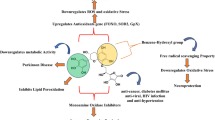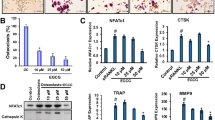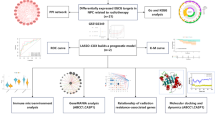Abstract
Aim:
Epigallocatechin-3-gallate (EGCG) is the major polyphenolic constituent in green tea. The aim of this study is to investigate the effects of EGCG on proliferation and migration of the human colon cancer SW620 cells.
Methods:
Proliferation and migration of SW620 cells were induced by the protease-activated receptor 2-agonist peptide (PAR2-AP, 100 μmol/L) or factor VIIa (10 nmol/L), and analyzed using MTT and Transwell assays, respectively. The cellular cytoskeleton was stained with rhodamine-conjugated phalloidin and examined with a laser scanning confocal fluorescence microscope. The expression of caspase-7, tissue factor (TF) and matrix metalloproteinase (MMP)-9 in the cells was examined using QT-PCR, ELISA and Western blot assays. The activation of extracellular signal-regulated kinase 1 and 2 (ERK1/2) and nuclear factor-kappa B (NF-κB) signaling pathways was analyzed with Western blot.
Results:
Both PAR2-AP and factor VIIa promoted SW620 cell proliferation and migration, and caused cytoskeleton reorganization (increased filopodia and pseudopodia). Pretreatment with EGCG (25, 50, 75, and 100 μg/mL) dose-dependently blocked the cell proliferation and migration induced by PAR2-AP or factor VIIa. EGCG (100 μg/mL) prevented the cytoskeleton changes induced by PAR2-AP or factor VIIa. EGCG (100 μg/mL) counteracted the down-regulation of caspase-7 expression and up-regulation of TF and MMP-9 expression in the cells treated with PAR2-AP or factor VIIa. Furthermore, it blocked the activation of ERK1/2 and NF-κB (p65/RelA) induced by PAR2-AP or factor VIIa.
Conclusion:
EGCG blocks the proliferation and migration of SW620 cells induced by PAR2-AP and factor VIIa via inhibition of the ERK1/2 and NF-κB pathways. The compound may serve as a preventive and therapeutic agent for colon cancers.
Similar content being viewed by others
Log in or create a free account to read this content
Gain free access to this article, as well as selected content from this journal and more on nature.com
or
References
Rak J, Milsom C, Magnus N, Yu J . Tissue factor in tumour progression. Best Pract Res Clin Haematol 2009; 22: 71–83.
Khorana AA, Ahrendt SA, Ryan CK, Francis CW, Hruban RH, Hu YC, et al. Tissue factor expression, angiogenesis, and thrombosis in pancreatic cancer. Clin Cancer Res 2007; 13: 2870–5.
Petersen LC . Microarray studies of factor VIIa-activated cancer cells. Thromb Res 2008; 122: S11–3.
Krishnan R, Kotian PL, Chand P, Bantia S, Rowland S, Babu YS . Probing the S2 site of factor VIIa to generate potent and selective inhibitors: the structure of BCX-3607 in complex with tissue factor-factor VIIa. Acta Crystallogr D Biol Crystallogr 2007; 63: 689–97.
Morris DR, Ding Y, Ricks TK, Gullapalli A, Wolfe BL, Trejo J . Protease-activated receptor-2 is essential for factor VIIa and Xa-induced signaling, migration, and invasion of breast cancer cells. Cancer Res 2006; 66: 307–14.
Zerbib P, Grimonprez A, Corseaux D, Mouquet F, Nunes B, Petersen LC, et al. Inhibition of tissue factor-factor VIIa proteolytic activity blunts hepatic metastasis in colorectal cancer. J Surg Res 2009; 153: 239–45.
Kirkland JG, Cottrell GS, Bunnett NW, Corvera CU . Agonists of protease-activated receptors 1 and 2 stimulate electrolyte secretion from mouse gallbladder. Am J Physiol Gastrointest Liver Physiol 2007; 293: G335–46.
Zhou H, Hu H, Shi W, Ling S, Wang T, Wang H . The expression and the functional roles of tissue factor and protease-activated receptor-2 on SW620 cells. Oncol Rep 2008; 20: 1069–76.
Zhou H, Shi W, Zhou B, Guo D, Wang T . Tissue factor-factor VIIa regulates interleukin-8, tissue factor and caspase-7 expression in SW620 cells through protease-activated receptor-2 activation. Mol Med Rep 2010; 3: 269–74.
Khan N, Mukhtar H . Multitargeted therapy of cancer by green tea polyphenols. Cancer Lett 2008; 269: 269–80.
Yamauchi R, Sasaki K, Yoshida K . Identification of epigallocatechin-3-gallate in green tea polyphenols as a potent inducer of p53-dependent apoptosis in the human lung cancer cell line A549. Toxicol in Vitro 2009; 23: 834–9.
Versteeg HH, Schaffner F, Kerver M, Petersen HH, Ahamed J, Felding-Harbermann B, et al. Inhibition of tissue factor signaling suppresses tumor growth. Blood 2008; 111: 190–9.
Ou YQ, Chen LH, Li XJ, Lin ZB, Li WD . Sinomenine influences capacity for invasion and migration in activated human monocytic THP-1 cells by inhibiting the expression of MMP-2, MMP-9, and CD147. Acta Pharmacol Sin 2009; 30: 435–41.
Zhou B, Zhou H, Ling S, Guo D, Yan Y, Zhou F, et al. Activation of PAR2 or/and TLR4 promotes SW620 cell proliferation and migration via phosphorylation of ERK1/2. Oncol Rep 2011; 25: 503–11.
Guo D, Zhou H, Wu Y, Zhou F, Xu G, Wen H, et al. Involvement of ERK1/2/NF-κB signal transduction pathway in TF/FVIIa/PAR2-induced proliferation and migration of colon cancer cell SW620. Tumor Biol 2011; 32: 921–30.
Albrektsen T, Sørensen BB, Hjortø GM, Fleckner J, Rao LVM, Petersen LC . Transcriptional program induced by factor VIIa-tissue factor, PAR1 and PAR2 in MDA-MB-231 cells. J Thromb Haemost 2007; 5: 1588–97.
Yang CS, Wang X, Lu G, Picinich SC . Cancer prevention by tea: animal studies, molecular mechanisms and human relevance. Nat Rev Cancer 2009; 9: 429–39.
Lim YC, Park HY, Hwang HS, Kang SU, Pyun JH, Lee MH, et al. Epigallocatechin-3-gallate (EGCG) inhibits HGF-induced invasion and metastasis in hypopharyngeal carcinoma cells. Cancer Lett 2008; 271: 140–52.
Houben F, Ramaekers FC, Snoeckx LH, Broers JL . Role of nuclear lamina-cytoskeleton interactions in the maintenance of cellular strength. Biochim Biophys Acta 2007; 1773: 675–86.
Walsh JG, Cullen SP, Sheridan C, Lüthi AU, Gerner C, Martin SJ . Executioner caspase-3 and caspase-7 are functionally distinct proteases. Proc Natl Acad Sci U S A 2008; 105: 12815–9.
Gupta S, Hastak K, Afaq K, Ahmad N, Mukhtar H . Essential role of caspases in epigallocatechin-3-gallate-mediated inhibition of nuclear factor kappaB and induction of apoptosis. Oncogene 2004; 23: 2507–22.
Belting M, Ahamed J, Ruf W . Signaling of the tissue factor coagulation pathway in angiogenesis and cancer. Arterioscler Thromb Vasc Biol 2005; 25: 1545–50.
Annabi B, Currie JC, Moghrabi A, B′eliveau R . Inhibition of HuR and MMP-9 expression in macrophage-differentiated HL-60 myeloid leukemia cells by green tea polyphenol EGCG. Leuk Res 2007; 31: 1277–84.
Chen Y, Wang J, Yao Y, Yuan W, Kong M, Lin Y, et al. CRP regulates the expression and activity of tissue factor as well as tissue factor pathway inhibitor via NF-kappaB and ERK 1/2 MAPK pathway. FEBS Lett 2009; 583: 2811–8.
Balmanno K, Cook SJ . Tumour cell survival signalling by the ERK1/2 pathway. Cell Death Differ 2009; 16: 368–77.
Lee YK, Ng KM, Lai WH, Man C, Lieu DK, Lau CP, et al. Ouabain facilitates cardiac differentiation of mouse embryonic stem cells through ERK1/2 pathway. Acta Pharmacol Sin 2011; 32: 52–61.
Wang S, Liu Z, Wang L, Zhang X . NF-kappB signaling pathway, inflammation and colorectal cancer. Cell Mol Immunol 2009; 6: 327–34.
Awasthi V, Mandal SK, Papanna V, Rao LV, Pendurthi UR . Modulation of tissue factor–factor VIIa signaling by lipid rafts and caveolae. Arterioscler Thromb Vasc Biol 2007; 27: 1447–55.
Acknowledgements
This project was supported by the Provincial Science Foundation of Jiangsu (No BK2010336) and the Student's Scientific Research of Jiangsu University (No 09A080).
Author information
Authors and Affiliations
Corresponding author
Supplementary information
Supplementa1 Figure 1
The cell cycle distribution (A) of SW620 cells treated with EGCG or/and VIIa and the percentages of cell cycle phase (B) SW620 cells were plated at 1 × 106 cells in 6-well plates and pretreated with different concentrations of EGCG (0, 25, 50, 75, 100 μg/L) for 15 min, then incubated with VIIa (10 nmol/L) for 8 h. (JPG 186 kb)
Supplementa1 Figure 2
The effects of EGCG on SW620 cell viability by trypan blue exclusion SW620 cells were seeded at 1×104/well into a flat bottom 96-well plate and treated with different concentrations of EGCG (0, 25, 50, 75, 100 μg/L) for 6, 12 and 24 h. (JPG 61 kb)
Supplementa1 Figure 3
The images of migration assay SW620 cells were pretreated with or without EGCG (100 μg/ml) for 15 min and then incubated with PAR2-AP (100 μmol/L) or factor VIIa (10 nmol/L) for 8 h. (JPG 159 kb)
Rights and permissions
About this article
Cite this article
Zhou, F., Zhou, H., Wang, T. et al. Epigallocatechin-3-gallate inhibits proliferation and migration of human colon cancer SW620 cells in vitro. Acta Pharmacol Sin 33, 120–126 (2012). https://doi.org/10.1038/aps.2011.139
Received:
Accepted:
Published:
Issue date:
DOI: https://doi.org/10.1038/aps.2011.139
Keywords
This article is cited by
-
Greasing the Wheels of Pharmacotherapy for Colorectal Cancer: the Role of Natural Polyphenols
Current Nutrition Reports (2023)
-
The combined use of Camellia sinensis and metronomic zoledronic acid in a breast cancer-induced osteolysis mouse model
Journal of Cancer Research and Clinical Oncology (2015)



